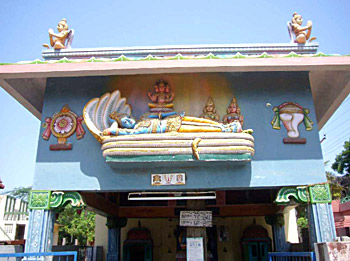 The architecture of the temple provides an artistic grandeur to the temple. The excellence of the artistic craftsmanship of the contemporary period is revealed from the structural design of the sanctum and the very carvings and the construction of the images. The principal deity or the moolavar is enshrined in the main sanctum. The presiding deity worshiped here is known as Neelavarna Purana.The imposing image of the Lord is extremely captivating. In the shrine he is seen in a standing (sthanaka) posture with four arms (Chaturbhuja) surrounded by His consorts Sri Devi and Bhu Devi on either side. His upper right and left hands hold the discus (chakra) and conch (sankha) respectively, while His front right hand is placed in abhaya hasta pose, offering protection to His devotees and His lower left hand in kati hasta posture, resting on His left thigh. The utsava murti or the processional image is also a four-armed Vishnu flanked by His consorts.
The architecture of the temple provides an artistic grandeur to the temple. The excellence of the artistic craftsmanship of the contemporary period is revealed from the structural design of the sanctum and the very carvings and the construction of the images. The principal deity or the moolavar is enshrined in the main sanctum. The presiding deity worshiped here is known as Neelavarna Purana.The imposing image of the Lord is extremely captivating. In the shrine he is seen in a standing (sthanaka) posture with four arms (Chaturbhuja) surrounded by His consorts Sri Devi and Bhu Devi on either side. His upper right and left hands hold the discus (chakra) and conch (sankha) respectively, while His front right hand is placed in abhaya hasta pose, offering protection to His devotees and His lower left hand in kati hasta posture, resting on His left thigh. The utsava murti or the processional image is also a four-armed Vishnu flanked by His consorts.
The fascinating feature of the temple architecture is revealed from the excellent structure of the temple. There is no separate sanctum for Goddess Lakshmi. She is known as Vedavalli Thayar, in this small temple and is worshipped in the space immediately in front of the main sanctum. In this place is also carved a sculpture of Svami Nammazhvar, facing the Goddess. The rituals of this shrine are conducted according to the principles of the Vaikhanasa Agama.
The entrance of the temple also testifies the architectural craftsmanship of the contemporary era. It is entered through a mandapa called Dasavatara Sopana Mandapa, which is supported by a pillar called dhvajastambha; apart from this the other supporting pillars also enhanced the structural design of the temple. These are called bali-pitha and Deepa-stambha. The architectural carvings on the temple walls display ten incarnations of Lord Vishnu (Dasavatara), besides the images of Goddess Gajalakshmi and Andal. A small shrine for Sri Garuda, standing with folded hands (anjali hasta) faces the main sanctums is extremely fascinating. Inside the sanctum there are two niches on either side of the doorway leading to another mandapa. This mandapa houses the ancient sculptures of Anjaneya also in anjali mudra. The enchanting images of the deities all the more endowed the temple with an artistic view, which enhanced the traditional greatness of the temple.
In the second mandapa, which is immediately in front of the main shrine, houses an exquisite image of Lord Sudarsana (Chakrattazhvar), He is also found to be assisted with Narasimha in his Yogic posture on the other side. Although this mandapa has been considerably modernized by laying granite slabs and other renovations, vestiges of its antiquity are still seen in the upper portions of the pillars supporting the roof and the sculptures on the ceiling. Due to this the traditional importance of the temple is also enhanced.





















